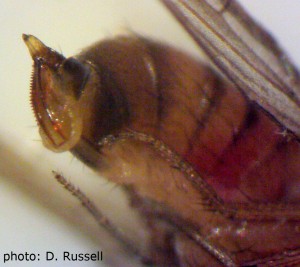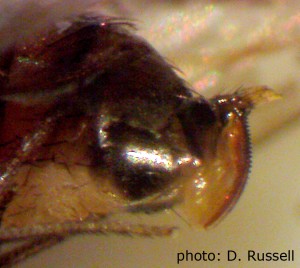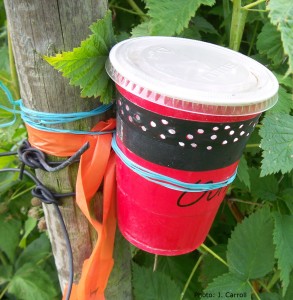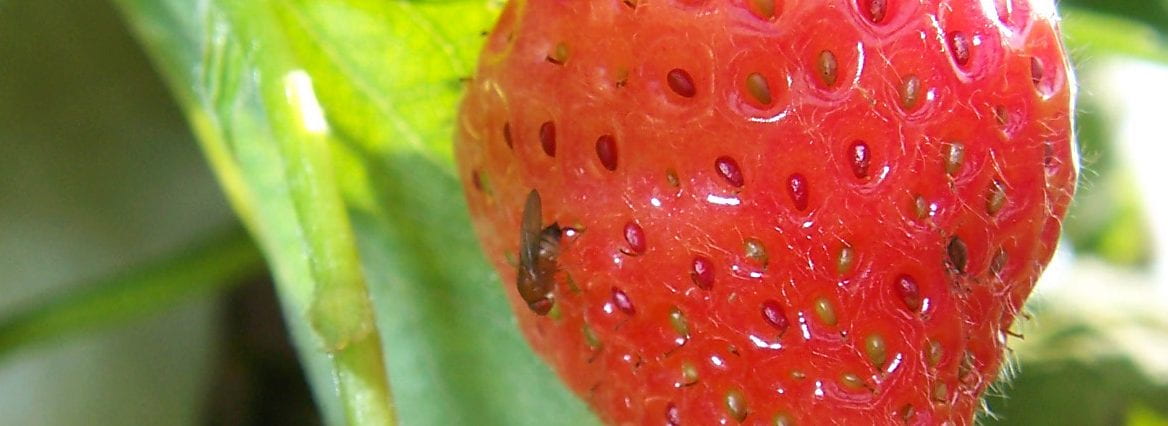Two female SWD were caught in traps collected on July 9, 2015 in Seneca County. One SWD in a trap for the network (whole wheat dough lure with apple cider vinegar drowning solution) and one caught in a Scentry trap. Traps were on the edge of a blueberry planting. (GDD = 1195, day length = 15:04)
Category: SWD reports
First catch in Yates County
Two female SWD were caught in traps on the edge of a summer raspberry planting. One each were caught in a Scentry trap and a standard Trece trap as part of a research project comparing traps and lures. Both traps use unscented soapy water for the drowning solution. Traps were collected on July 7, 2015 by Gabe Brind'Amour in Greg Loeb's entomology program at Cornell University.
First catch in Ontario County
A single female SWD was caught in a whole wheat dough with apple cider vinegar trap (SWD network) and another single female was caught in a Scentry trap with combination lure (research project). These traps are both on the edge of a blueberry planting in Ontario County. Traps were collected on 7/7/15 by Gabe Brind'Amour in Greg Loeb's Small Fruit Entomology Program, NYS Ag Experiment Station, Cornell University.
First catch in Genesee County
A single female SWD was caught in a trap collected on July 8, 2015 from within a summer raspberry planting in Genesee County. Master Gardener David Russell and Extension Educator Janice Beglinger of Genesee County Cornell Cooperative Extension are monitoring the traps at this location. Photos of the female ovipositor were sent in to verify their SWD identification. (GDD = 1038, day length = 15:08)


First “network” catch in Schuyler County
Three SWD, two females and one male, were caught in traps set in a summer raspberry planting in Schuyler County that were checked on July 2, 2015. This site is part of the trap network, being monitored by Gabrielle (Gabe) Brind'Amour, technician in Greg Loeb's small fruit entomology program, Cornell University. At this location, they also have other traps set out for research purposes, and SWD was also caught in several of those traps. It is time to put an SWD management plan into place, if you have susceptible, ripe fruit at your farm.

First catch in Cayuga County

One male SWD was caught in a trap collected on July 2, 2015 in Cayuga County. The trap was set on the edge of a blueberry planting adjacent to woods by Juliet Carroll, Fruit IPM Program, and is being serviced by summer technician Tyler Sollenne. The blueberry planting is located in the northern part of Cayuga County. Three other traps at the site contained no SWD.
Because of the early arrival of SWD, blueberries should be protected from infestation by careful planning of an insecticide program as fruit begin to ripen. Other steps to manage SWD include removal from the planting of overripe fruit in which SWD larvae could be developing, mowing and weed control to reduce humidity and shading in the planting—conditions favorable for SWD. (GDD = 999, day length = 15:15)
Sustained catch in Wayne County
A female SWD was caught in Wayne County on July 2, 2015, marking a second, consecutive week of SWD trap capture at this location. Traps are set in summer raspberries and serviced by the Fruit IPM Program. Earliest fruit are ripe and more are coming on for a bountiful season. Protecting the crop with an insecticide program at this location will be essential.

If you are monitoring traps at your farm, it will be best to check traps daily. This way there will be fewer non-target fruit flies and other insects in your traps. Tips for identifying SWD and infested fruit are found on the SWD webpages on Cornell Fruit Resources, www.fruit.cornell.edu.
SWD at second Schuyler County research site
One female SWD was caught in a trap collected on June 25, 2015 at a Schuyler County research site. The trap contained whole wheat fermenting bread dough as the lure and was located on the edge of a blueberry planting. (This site doesn't report to the SWD distribution map.)
The New York SWD distribution map reports will come from the NY monitoring network which has traps out in 29 Counties at 48 different sites. So far only Orange County and Wayne County traps in this network have caught SWD – a single female each.
People monitoring in the SWD network are with Cornell University’s College of Agriculture and Life Sciences and Cornell Cooperative Extension. Four traps are placed at each site, two within the crop, either raspberry or blueberry, and two on the edge of the crop, though some sites may have only two traps. Below is a table with details about the SWD network trap locations.
First catch in Wayne County
A single SWD female was caught on June 24, 2015 in Wayne County at a site in our monitoring network in a trap baited with the standard fermenting whole wheat bread dough. This site is being monitored by Juliet Carroll, NYS IPM Program. Her technician Nicole Mattoon identified the lone female among the other insects in the trap. The trap was located within a summer raspberry planting. Fruit are beginning to ripen at this location. This farm also has June strawberry nearing the end of harvest, sweet cherry, peach, blueberry and day neutral strawberry. It is time to carefully plan out the best strategy for your farm to manage SWD on vulnerable crops. (GDD = 805, day length = 15:20)
SWD caught in Orange County
A single female was caught at a research site in Orange County using a baited Trécé trap, set during the week of June 15th-22nd by Peter Jentsch, entomologist, Hudson Valley Laboratory, Cornell University. The trap uses a combination lure incorporating both pheromone and kairomone—a feeding attractant. Jentsch examined red raspberry fruit from a 25-count-sample collected on Monday the 22nd (var. Caroline) and no ovipositional stings or egg breathing tubes were found. Read more on The Jentsch Lab blog.

These females are capable of laying eggs, so it is time to get set, get ready, and go protect your fruit crops. June strawberry harvest is winding down, so this crop may not need protection. Summer raspberry is showing ripe fruit now and will be at risk in 2015. Sweet cherry and tart cherry will be at risk, since they may ripen and be harvested over the next few weeks, consider what materials you have in your insecticide programs and make sure that SWD is covered.
The research comparing different lures for catching SWD early is ongoing at three locations in NY - comparisons are being done between a Trécé lure, a Sentry lure, a boosted lure from Trécé, the standard fermenting bread dough (used in the NY monitoring network), Cha Landolt synthetic lure, and apple cider vinegar alone. These research sites aren't included on the SWD distribution map, so don't be confused by Orange County still showing in gray for none found. This means there have been none found in the monitoring network sites in Orange County.


